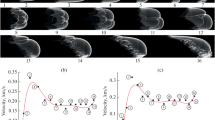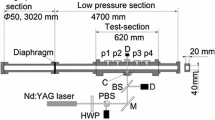Abstract
The aim of this work was to study the dynamics of deflagration-to-detonation transition (DDT) following flame acceleration in a cylindrical tube. We combined high-speed video recordings of self-luminescence and traditional local flow measurements to study the DDT process in a stoichiometric acetylene–oxygen mixture with argon dilution and nitrogen dilution. Experiments were carried out in a cylindrical tube with an inner diameter of 0.04 m and a low-energy ignition source (the ignition energy 0.8 mJ). The quantitative data on the dynamics of the shock wave and the local flame velocities, the spatial behavior of the flame during its acceleration, the flame extension, and the distance between the shock wave and the flame front were obtained. The locations of hot spots relative to the spatial configuration of the accelerating flame front and the tube walls were found as well. The local flow temperatures required for hot-spot formation were evaluated from the experimental measurements of induction zone length and the comparison of ignition delay times of similar mixtures obtained behind the reflected shock waves in shock tube tests. The following results were obtained from the experiments. At flame velocities near the isobaric sound speed of combustion products, the spatial configuration of the flame was stable, and one or several hot spots were initiated ahead of the flame near the tube wall. The distance between hot spots and the leading tip of the flame did not exceed 0.4 m. Depending on the mixture sensitivity, weak, transient, or strong ignition modes were observed. For hot-spot formation, the actual local temperature in the induction zone between the leading edge of the flame front and the shock wave should be 100–200 K higher than the post-shock temperature deduced from a one-dimensional model. The higher post-shock mixture condition in the induction zone is due to an additional local transverse adiabatic compression of unburnt mixture near the tube wall, which is generated by the inclined flame front.










Similar content being viewed by others
References
Dziemińska, E., Hayashi, A.K.: Auto-ignition and DDT driven by shock wave–boundary layer interaction in oxyhydrogen mixture. Int. J. Hydrogen Energy 38, 4185–4193 (2013). https://doi.org/10.1016/j.ijhydene.2013.01.111
Oran, E.S., Gamezo, V.N.: Origins of the deflagration-to-detonation transition in gas-phase combustion. Combust. Flame 148, 4–47 (2007). https://doi.org/10.1016/j.combustflame.2006.07.010
Schelkin, K.I.: Effect of tube roughness on the occurrence and propagation of detonation in gases. Zh. Eksp. Teor. Fiz. 10(7), 823–827 (1940) (in Russian)
Schelkin, K.I., Troshin, T.K.: Gasdynamics of Combustion. Mono Books, Baltimore (1965)
Soloukhin, R.I.: Shock Waves and Detonations in Gases. Mono Books, Baltimore (1966)
Oppenheim, A.K., Soloukhin, R.I.: Experiments in gasdynamics of explosions. Annu. Rev. Fluid Mech. 5, 31–58 (1973). https://doi.org/10.1146/annurev.fl.05.010173.000335
Salamandra, G.D., Bazhenova, T.V., Zaicev, S.G., Soloukhin, R.I., Naboko, I.M., Sevastyanova, I.K.: Some Methods for Investigation of Fast-Running Processes. Acad. Nauk SSSR, Moscow (1960) (in Russian)
Eder, A., Brehm, N.: Analytical and experimental insights into fast deflagrations, detonations, and the deflagration-to-detonation transition process. Heat Mass Transf. 37(6), 543–548 (2001). https://doi.org/10.1007/s002310100238
Urtiew, P.A., Oppehheim, A.K.: Experimental observations of the transition to detonation in an explosive gas. Proc. R. Soc. Ser. A 295, 13–28 (1966). https://doi.org/10.1098/rspa.1966.0223
Penyazkov, O.G., Ragotner, K.A., Dean, A.J., Varatharajan, B.: Autoignition of propane-air behind reflected shock waves. Proc. Combust. Inst. 30, 1941–1947 (2005). https://doi.org/10.1016/j.proci.2004.08.122
Sevrouk, K.L., Krivosheyev, P.N., Penyazkov, O.G., Torohov, S.A., Titova, N.S., Starik, A.M.: Numerical and experimental analysis of propane–hydrogen mixture ignition in air. J. Phys. Conf. Ser. 774(1), 1–7 (2016). https://doi.org/10.1088/1742-6596/774/1/012083
Voevodsky, V.V., Soloukhin, R.I.: On the mechanism and explosion limits of hydrogen–oxygen chain self-ignition in shock waves. Proceedings of the X International Symposium on Combustion, pp. 279–283. The Combustion Institute, Pittsburgh (1965). https://doi.org/10.1016/s0082-0784(65)80173-4
Soloukhin, R.I.: Deflagration to detonation transition in gases. J. Appl. Mech. Technol. Phys. 4, 128–132 (1961) (in Russian)
Kuznetsov, M., Alekseev, V., Matsukov, I., Dorofeev, S.: DDT in a smooth tube filled with a hydrogen–oxygen mixture. Shock Waves 14(3), 205–215 (2005). https://doi.org/10.1007/s00193-005-0265-6
Liberman, M.A., Kuznetsov, M., Ivanov, A., Matsukov, I.: Formation of the preheated zone ahead of a propagating flame and the mechanism underlying the deflagration-to-detonation transition. Phys. Lett. A 373, 501–510 (2009). https://doi.org/10.1016/j.physleta.2008.12.008
Author information
Authors and Affiliations
Corresponding author
Additional information
Communicated by G. Ciccarelli.
Publisher's Note
Springer Nature remains neutral with regard to jurisdictional claims in published maps and institutional affiliations.
Rights and permissions
About this article
Cite this article
Baranyshyn, Y.A., Krivosheyev, P.N., Penyazkov, O.G. et al. Flame front dynamics studies at deflagration-to-detonation transition in a cylindrical tube at low-energy initiation mode. Shock Waves 30, 305–313 (2020). https://doi.org/10.1007/s00193-020-00937-0
Received:
Revised:
Accepted:
Published:
Issue Date:
DOI: https://doi.org/10.1007/s00193-020-00937-0




